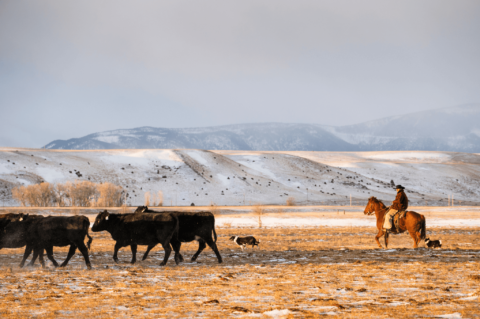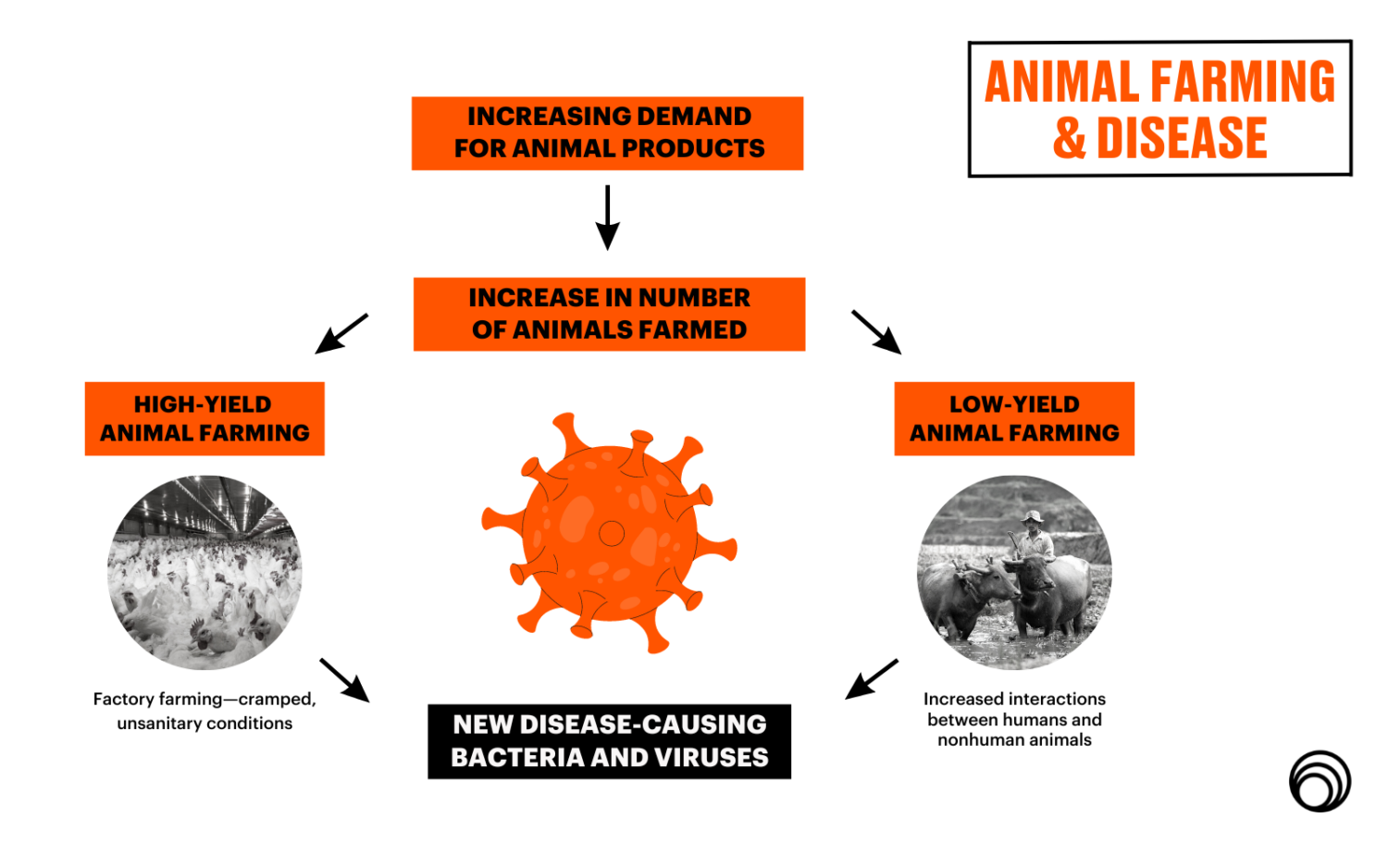Solutions
How Denver Could Become the First City to Ban Slaughterhouses
Food•7 min read
Reported
A growing body of evidence shows that both intensive and extensive farms are increasing the risk of the next pandemic.


Words by Devatha P. Nair
Most food reformers agree factory farms are a bad thing. In recent years, something called extensive farming has emerged as an alternative — more ethical, sustainable and better for our collective health. Extensive operations are a kind of animal farming where livestock are reared on much larger tracts of land, including traditional ways to raise meat like pastoralism as well as the more recent and trendy regenerative grazing.
The appeal is clear: wild and open spaces where animals graze where they please, supporting local farmers without harming the environment or triggering zoonotic outbreaks.
However, a growing body of evidence — including a 2022 study in Science Advances — casts doubt on the effectiveness of this agricultural system as an alternative, at least as far as zoonotic disease spread goes. It turns out both intensive and extensive farms are increasing the risk of the next pandemic.

At first glance, extensive farming operations seem to circumvent some of the worst conditions of factory farms that make disease outbreaks more likely. Unlike factory farms, where stressed animals are crowded within narrow, filthy stalls with little room to move, extensive farming systems allow animals to roam freely on larger tracts of land. And extensive farming isn’t (or at least aims not to be) so reliant on factory farming’s growth-promoting antibiotics.
The problem is this — even though extensive farming seems to offer animals better lives prior to slaughter, these same large tracts of land are also where livestock encroach on the natural habitats of all sorts of wildlife. And because these operations tend to lack the kind of supervision and biosecurity that a factory farm offers, livestock and their human handlers come into contact with wildlife and, if they’re carrying a pathogen, they can end up spreading disease.
Global demand for animal products is on the rise — driven by increasing populations and wealth in many parts of the world, and continued over-consumption in the global north. By the year 2050, demand for beef, poultry and pork is set to rise by 39, 58 and 55 percent, respectively.
Continuing to expand our current factory farm system would require more agricultural land than the planet has to offer. Yet trying to scale up and expand an extensive animal farm system — like one made up of regenerative ranches for instance — would require even more land than that. Moving away from factory farms would require land area almost the size of India, the seventh largest country in the world at 812.3 million acres. Our current system of meat production already takes up close to 80 percent of global agricultural land, even though it produces less than 20 percent of the world’s calories. That’s about the size of North and South America combined. Toss in India too, and our land use problems will only skyrocket.
What the Science Advances study highlights is how expanding or intensifying extensive animal farming also indirectly contributes to deforestation. When intensification makes meat cheaper, that inadvertently increases demand. The phenomenon is referred to as the ‘rebound effects’ or Jevons’ paradox, where the benefits of intensification — increased productivity — are offset by a resulting increase in demand. It sets in motion a constant and environmentally-damaging cycle — intensification makes farms more productive, meat gets cheaper, demand increases, which means farmers need to expand and that leads to more deforestation.
And another wrinkle is extensive farming can sometimes be intertwined with the factory farm system — as extensive farm operators send their cattle to feedlots at the end of their lives to fatten up on grain. Close to 80 percent of the global soy production and 61 percent of global corn production go towards feeding farmed animals. Increased demand for feed is also driving deforestation rates.
Deforestation has dire consequences for biodiversity — and that’s especially true with an extensive operation that allows cattle to range far and wide. Introducing animals such as cattle to wild lands can destabilize ecosystems and alter the delicate balance between the native plants and animals in their habitats.
Disturbing the balance of an ecosystem creates an opportunity for invasive plant and animal species to take over. The invasive species rapidly grow, spread, proliferate and, eventually, suffocate native species, harming the resilience of ecosystems and reducing biodiversity. That in turn opens the door for more contact between livestock and wildlife, which then increases the chance of a zoonotic disease outbreak.
That’s a huge problem because earth’s biodiversity is already in crisis. Numbers of animals living on the Earth has decreased by 60 percent since the 1970s. And a UN-backed study released in May 2019 confirmed that we are now on the way to the sixth great extinction.
Beyond the incalculable loss of life, both on an individual and ecosystem-wide level, reduced biodiversity rates also make us humans far more vulnerable to pandemics. When the variety of species found within ecosystems declines, disease transmission goes up, and so does the risk of exposing humans to all sorts of zoonotic pathogens, new and old alike.
At the same time, factory farms aren’t off the hook either. These concentrated animal feeding operations (CAFOs) or intensive livestock operations are also notorious hotbeds for the emergence and spread of zoonotic diseases.
Driven by the global demand for meat and dairy products, such facilities exist to prioritize productivity, not the health and well-being of animals. Over 99 percent of the animal products in the U.S. comes from such factory farms where animals are fed and fattened while housed in appalling conditions for a fraction of their natural lifespans en route to slaughter. Globally, over 70 billion animals are farmed annually, out of which 50 million of them are reared in factory farms across the world.
As animals and birds continue to be bred in high-density farms to meet the rising demand for meat and dairy, the lines between infectious diseases that originate from wild animals and captive animals continue to blur.
The ongoing global avian flu outbreak in factory farms is a perfect example of how zoonotic illness can continually cycle between wild birds and captive birds for months and now years on end. Since October 2021, 140 million poultry have been killed worldwide and as of November 2022, more than 49 million birds have been culled or have died as a result of exposure to the H1NA bird flu virus in the U.S. alone. While still below the 50.5 million birds that were killed in the U.S. during the 2015 bird flu outbreak, the number of birds that will have to be culled is still projected to grow in the coming months, with no end in sight.
Currently, with over 200 million land animals slaughtered each day for food, our unsustainable food systems across the globe continue to be prime breeding grounds for infectious disease outbreaks. The UN Environment Programme has linked the emergence of human-mediated zoonotic diseases to seven trends — including our insatiable demand for animal protein, unsustainable agricultural intensification practices and the increased use and exploitation of wildlife.
In addition to improved conservation and governance of forests across the globe, preventing the next pandemic will require significant dietary shifts away from animal products, the study contends. But that can only be achieved with deliberate, well-thought-out strategy. Absent this kind of substantial and science-driven policy change, it’s only a matter of time before it sets off the next pandemic.